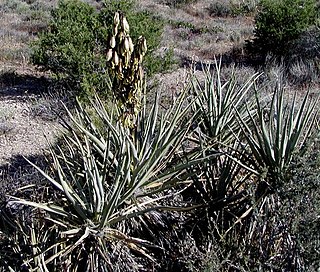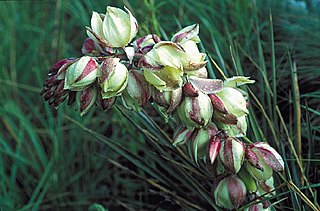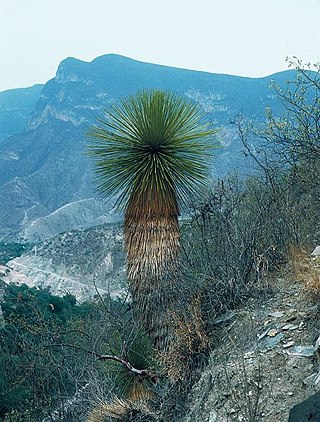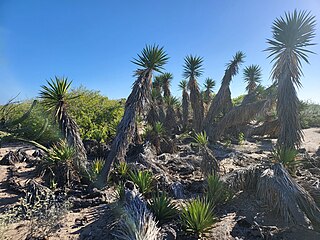
Agave americana, commonly known as the century plant, maguey, or American aloe, is a flowering plant species belonging to the family Asparagaceae. It is native to Mexico and the United States, specifically Texas. This plant is widely cultivated worldwide for its ornamental value and has become naturalized in various regions, including Southern California, the West Indies, South America, the Mediterranean Basin, Africa, the Canary Islands, India, China, Thailand, and Australia.

Yucca baccata is a common species of yucca native to the deserts of the southwestern United States and northwestern Mexico, from southeastern California north to Utah, east to western Texas and south to Sonora and Chihuahua. It is also reported in the wild in Colombia.

Yucca schidigera, also known as the Mojave yucca or Spanish dagger, is a flowering plant native to the southwest deserts of North America.

Hesperoyucca whipplei, the chaparral yucca, our Lord's candle, Spanish bayonet, Quixote yucca or foothill yucca, is a species of flowering plant closely related to, and formerly usually included in, the genus Yucca. It is native to southwest communities of North America.

Agave is a genus of monocots native to the hot and arid regions of the Americas and the Caribbean, although some Agave species are also native to tropical areas of North America, such as Mexico. The genus is primarily known for its succulent and xerophytic species that typically form large rosettes of strong, fleshy leaves. Agave now includes species formerly placed in a number of other genera, such as Manfreda, ×Mangave, Polianthes and Prochnyanthes.

Yucca glauca is a species of perennial evergreen plant, adapted to xeric (dry) growth conditions. It is also known as small soapweed, soapweed yucca, Spanish bayonet, and Great Plains yucca.

Yucca × schottii is a plant species in the genus Yucca, native to southern Arizona, southwestern New Mexico, and the northern parts of Sonora and Chihuahua. The common names are Schott's yucca, hoary yucca, and mountain yucca. The "×" in the name indicates that this is a nothospecies, regarded as being a natural hybrid between two other species. In this case, Yucca × schottii is believed to have originated as a hybrid between Y. baccata and Y. madrensis. Yucca × schottii is firmly established and does reproduce freely in the wild.

Agave parviflora is a species of succulent perennial flowering plant in the asparagus family, known by the common names Santa Cruz striped agave, smallflower century plant, and small-flower agave. It is native to Arizona in the United States and Sonora in Mexico.

Agave shrevei is a member of the family Asparagaceae, indigenous to the Sierra Madre Occidental in Mexico, along the boundary between the states of Chihuahua and Sonora. Two subspecies are currently recognized, although a third has been proposed.
Hymenocallis clivorum is a member of the genus Hymenocallis, of the plant family Amaryllidaceae. It is native to the southern part of the Mexican state of Sonora.

Yucca madrensisH. S. Gentry is a plant in the genus Yucca in the family Asparagaceae. It is native to a mountainous region in the Sierra Madre Occidental in the Mexican states of Sonora and Chihuahua. It has also been reported from Arizona It grows on steep, rocky slopes in pine-oak forests.

Yucca arkansana, the Arkansas yucca, is a plant in the family Asparagaceae, native to Texas, Oklahoma, Arkansas, Missouri and Kansas. It generally grows in gravelly, sunlit locations such as rocky outcrops, prairies, etc. It is not considered to be threatened.

Yucca angustissima, the narrowleaf yucca, is a plant in the family Agavaceae, known as the "narrow-leaved yucca." It is native to Arizona, New Mexico, Colorado and Utah, but grown elsewhere as an ornamental.

Yucca neomexicanaWooton & Standl. is a plant in the family Asparagaceae, native to New Mexico, Colorado and Oklahoma. Common name is "New Mexican Spanish bayonet." It is similar to Y. harrimaniaeTrel. but with a longer flowering stalk and white flowers.

Yucca queretaroensis is a plant species in the genus Yucca, family Asparagaceae, native to the Sierra Madre Occidental of the Mexican states of Hidalgo, Guanajuato, and Querétaro. It is poorly known, largely because of the rugged terrain of its native habitat.

Yucca valida is a plant species in the family Asparagaceae, native to the Mexican states of Baja California, Baja California Sur, Sonora, and Sinaloa. The common name is datilillo.

Yucca constricta known by the common name "Buckley's yucca," is a plant in the family Asparagaceae. It is found in rocky limestone hills of central and eastern Texas, and also in Coahuila, Mexico.

Yucca treculianaCarrière is a species of flowering plant in the family Asparagaceae, native to Texas, New Mexico and Coahuila. Common names include Spanish dagger, Spanish bayonet and Don Quixote's lance.
Yucca tenuistyla is a species of flowering plant in the family Asparagaceae found in brushlands near the coast of Texas, at elevations below 200 m. Common names include white-rimmed yucca and whiterim yucca.

Yucca aloifolia is the type species for the genus Yucca. Common names include aloe yucca, dagger plant, and Spanish bayonet. It grows in sandy soils, especially on sand dunes along the coast.



















